
Nepal measures about 800 kilometers (497 mi) along its Himalayan axis by 150 to 250 kilometers across. Nepal has an area of 147,181 square kilometers (56,827 sq mi).
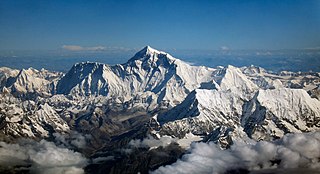
The Himalayas, or Himalaya, form a mountain range in Asia, separating the plains of the Indian subcontinent from the Tibetan Plateau.

The Bagmati River runs through the Kathmandu Valley of Nepal and separates Kathmandu from Patan. It is considered holy by both Hindus and Buddhists. A number of Hindu temples are located on its banks.
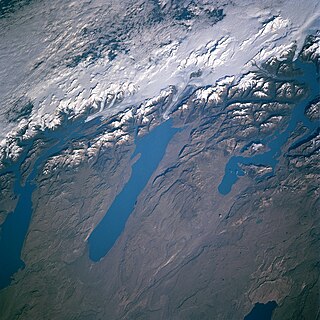
In geology, a proglacial lake is a lake formed either by the damming action of a moraine during the retreat of a melting glacier, a glacial ice dam, or by meltwater trapped against an ice sheet due to isostatic depression of the crust around the ice. At the end of the last ice age approximately 10,000 years ago, large proglacial lakes were a widespread feature in the northern hemisphere.

Dudh Koshi is a river in eastern Nepal. It is the highest river in terms of elevation.
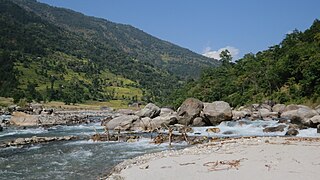
The Tamur River, also called Tamor Nadi, is a major river in eastern Nepal, which begins around Kanchenjunga. The Tamur and the Arun join the Sun Kosi at Tribenighat to form the giant Saptakoshi which flows through Mahabharat Range on to the Gangetic plain

Sindhupalchok District is a part of Province No. 3 and one of the seventy-seven districts of Nepal, with an area of 2,542 km2 (981 sq mi). The district's headquarters is in Chautara. In 2006, 336,478 people resided in 79 village development committees, in 2011 there were 287,798.
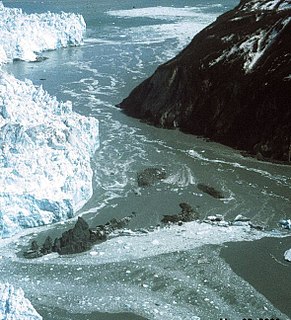
A glacial lake outburst flood (GLOF) is a type of outburst flood that occurs when the dam containing a glacial lake fails. An event similar to a GLOF, where a body of water contained by a glacier melts or overflows the glacier, is called a Jökulhlaup. The dam can consist of glacier ice or a terminal moraine. Failure can happen due to erosion, a buildup of water pressure, an avalanche of rock or heavy snow, an earthquake or cryoseism, volcanic eruptions under the ice, or if a large enough portion of a glacier breaks off and massively displaces the waters in a glacial lake at its base.

The Arun River is a trans-boundary river and is part of the Kosi or Sapt Koshi river system in Nepal. It originates in Tibet Autonomous Region of the People's Republic of China where it is called the Phung Chu or Bum-chu.
The Inner Terai Valleys of Nepal comprise several elongated river valleys in the southern lowland Terai part of the country. These tropical valleys are enclosed by the Himalayan foothills, viz the Mahabharat Range and the Sivalik Hills farther south. The Inner Terai is called "bhitri Terai " in Nepali language.
The Kosi embankments were built in late 1950s to retain the Kosi River which is a transboundary river between Nepal and India and is one of the largest tributaries of the Ganges. It was conceptualised during the first Bihar Government of CM Shri Babu and his deputy Anugraha Babu. According to the agreement with Nepal, the responsibility of maintaining these embankments was vested in the Government of Bihar.

The Indravati River in Nepal is a tributary of the Sun Koshi River. It used to be called "Melamchi" or "Melamchu" until the 19th century.
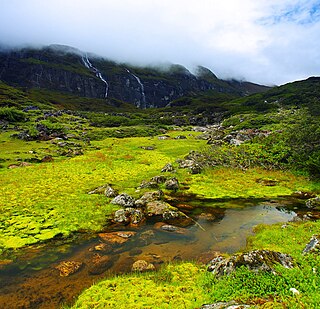
The Barun River is a tributary of the Arun River and is part of the Kosi river system in Nepal.
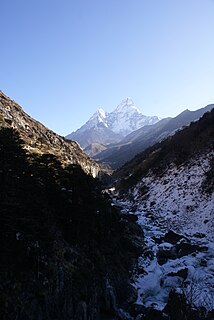
The Imja Khola is a tributary of the Dudh Kosi in Nepal. It drains the slopes of Mount Everest. The Khumbu Glacier melts into the Lobujya (Lobuche) River, which flows southward as the Imja Khola to its confluence with the Dudh Kosi at Tengboche.

Imja Tsho is a glacial lake created after melt water began collecting at the foot of the Imja Glacier on the lower part of the glacier in the 1950s. A 2009 study described this lake of melt water as one of the fastest-growing in the Himalaya. Held in place by a terminal moraine, Imja Tsho threatens downstream communities with the potential for a glacial outburst flood.
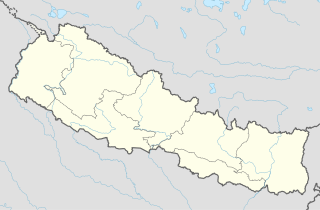
The Chatra Gorge is a canyon cut by the Kosi River across the Mahabharat Range in Nepal.
In 2010, the Government of Nepal approved National Adaptation Programme of Action (NAPA). NAPA developed as a requirement under the UNFCCC to access funding for the most urgent and immediate adaptation needs from the Least Developed Countries Fund (LDCF).
























